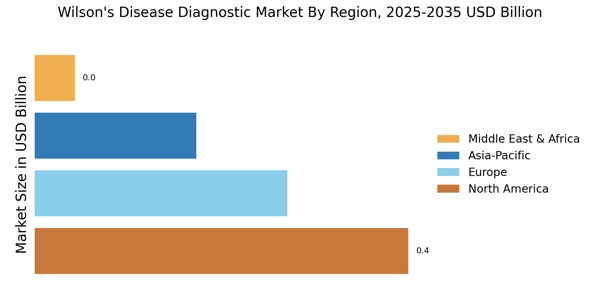Rising Prevalence of Wilson's Disease
The increasing incidence of Wilson's disease is a pivotal driver for the Wilson's Disease Diagnostic Market. As awareness of this genetic disorder grows, more individuals are being diagnosed, leading to a heightened demand for effective diagnostic tools. Recent estimates suggest that Wilson's disease affects approximately 1 in 30,000 individuals, with many cases remaining undiagnosed. This rising prevalence necessitates the development and availability of advanced diagnostic solutions, thereby propelling market growth. Furthermore, the need for early detection to prevent severe liver and neurological complications underscores the importance of accurate diagnostic methods. As healthcare systems prioritize the identification of rare diseases, the Wilson's Disease Diagnostic Market is likely to experience significant expansion in response to these trends.
Advancements in Diagnostic Technologies
Technological innovations in diagnostic methodologies are transforming the Wilson's Disease Diagnostic Market. The introduction of novel techniques, such as next-generation sequencing and advanced imaging technologies, enhances the accuracy and speed of diagnosis. These advancements facilitate the identification of genetic mutations associated with Wilson's disease, allowing for earlier intervention and management. Moreover, the integration of artificial intelligence in diagnostic processes is streamlining data analysis, potentially improving patient outcomes. As healthcare providers increasingly adopt these cutting-edge technologies, the market for Wilson's disease diagnostics is expected to grow. The ongoing research and development efforts in this field indicate a promising future for innovative diagnostic solutions, which could further elevate the standards of care for patients.
Increased Focus on Rare Disease Research
The growing emphasis on rare disease research is significantly influencing the Wilson's Disease Diagnostic Market. Governments and private organizations are allocating substantial resources to understand and treat rare conditions, including Wilson's disease. This focus is fostering collaborations between research institutions and diagnostic companies, leading to the development of specialized tests and screening programs. For instance, initiatives aimed at improving awareness and education about Wilson's disease are likely to enhance early diagnosis rates. As funding for rare disease research continues to rise, the Wilson's Disease Diagnostic Market stands to benefit from increased investment in innovative diagnostic solutions, ultimately improving patient care and outcomes.
Growing Patient Advocacy and Support Groups
The rise of patient advocacy and support groups is playing a vital role in shaping the Wilson's Disease Diagnostic Market. These organizations are instrumental in raising awareness about Wilson's disease, promoting early diagnosis, and advocating for better treatment options. By providing resources and support to patients and families, these groups are fostering a community that encourages individuals to seek medical attention. Their efforts are likely to lead to increased screening and diagnostic testing, thereby driving market growth. Furthermore, collaboration between advocacy groups and healthcare providers can enhance the development of tailored diagnostic solutions that meet the specific needs of patients. As these advocacy efforts continue to expand, the Wilson's Disease Diagnostic Market is expected to benefit from heightened awareness and demand for effective diagnostic tools.
Regulatory Support for Diagnostic Innovations
Regulatory bodies are increasingly supporting the development of innovative diagnostic tools for Wilson's disease, which is a crucial driver for the Wilson's Disease Diagnostic Market. Streamlined approval processes and incentives for diagnostic companies are encouraging the introduction of new tests and technologies. This regulatory environment fosters competition and innovation, allowing for a diverse range of diagnostic options to emerge. Additionally, the establishment of guidelines for the diagnosis and management of Wilson's disease by health authorities is likely to standardize practices and improve patient access to necessary diagnostics. As regulatory support continues to evolve, the Wilson's Disease Diagnostic Market is poised for growth, driven by the introduction of effective and reliable diagnostic solutions.


















Leave a Comment